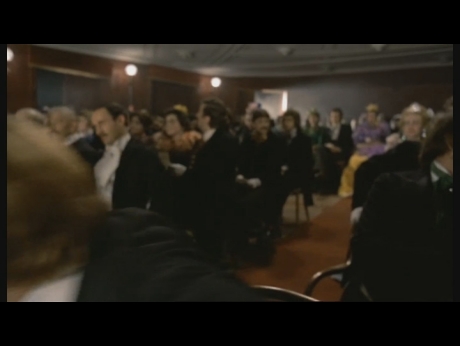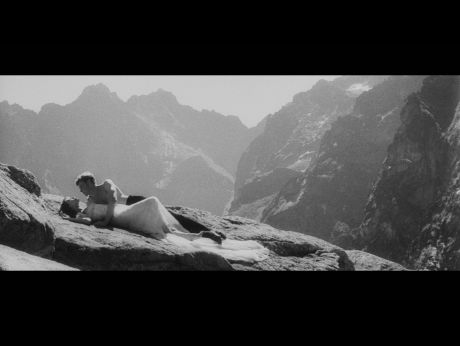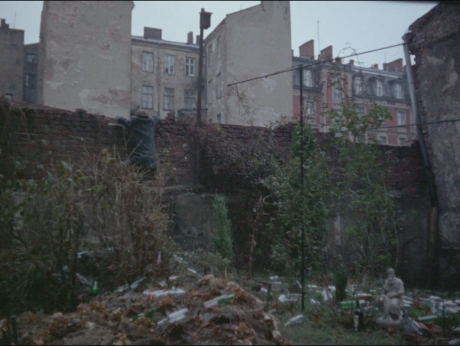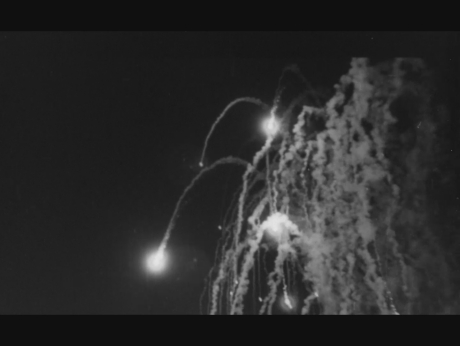
 overview
overview
September of 1939. The Polish Ulan squadron receives a beautiful, white mare – Lotna. They establish an order of who gets to ride her. The Ulan’s commander, cavalry captain Chodakiewicz, receives Lotna first. From then on the tragic fate of the squadron and the beautiful horse is connected…

 storyline
storyline
The tragic September of 1939. The sound of shooting in the background. A horse galloping around the fire. He manages to run away. The Polish Ulan squadron stays in the palace. Lotna, a beautiful white mare receives everyone’s attention. She is the same one seen a moment ago. The sergeant major Latoń is extremely impressed, lieutenant Wodnicki and officer cadet Grabowski tell each other that it would be wonderful to have such a horse. Their host is very sick, dying. Lotna stays by his bedside. The old man is worried about her fate when he will be gone. He therefore gives her to cavalry captain Chodakiewicz, who is the Ulans’ commander. Everyone is jealous. In the evening they draw lots to see who will have her if Chodakiewicz dies. They establish an order: officer cadet Grabowski will get the horse, and if he dies, lieutenant Wodnicki will.
The squadron continues on their way for further battle. An exodus of the people begins. Civilians are running away on all of the roads. Peasant wagons, cars and trolleys are everywhere. A few soldiers try to prepare positions for shooting. Suddenly German planes appear. There is panic, the cattle starts to run away, people hide, there are many killed. Chodakiewicz knows that his squadron has been surrounded by Germans. He tries to get out of the encirclement. He takes his people through the woods. They have gotten away, but every day they run into another German division with tanks.
The Polish Ulans make an attack on the tanks. They are decimated, Chodakiewicz also dies – Lotna drags his body by his leg. His body is covered with a coat and taken to a country house where women pray for him. The local parson is called for. He too cannot hide how fascinated he is by Lotna. From underneath his cassock jodhpurs are visible. Despite sergeant major Latoń’s protest – he is afraid that the parson will make him clubfooted – the parson takes the horse. He puts a coin between his knee and the side of the horse. He rides on, jumping over obstacles. The others see that the coin remains where he put it.
Lotna is taken over by Grabowski. During their next stop he visits the local school where he meets Ewa, his old friend from school, who he used to be in love with. She is a teacher here. Grabowski’s love is reborn. In these wartime circumstances they become close very fast and decide to get married. After their wedding the remainder of the squadron moves on. Ewa follows them on a wagon. She is worried that her husband is more interested in Lotna than in her. Suddenly the Germans appear and Grabowski dies in battle. His deputy commanders dig him a grave and pay their respect to him. Ewa is devastated, she throws herself on the grave.
In accordance with the agreement, Wodnicki takes Lotna now. He sees no point in further battle. He lets his people go and gives each of them a fragment of the torn squadron banner. He takes the part with the words “Honour and Homeland”. He rides away on Lotna, but during the night when he is asleep, the horse is stolen by sergeant major Latoń. However, he isn’t happy for too long, because Lotna breaks her leg in the wheels of a wagon. An angry Wodnicki arrives. When he sees what happened, he decides to kill her with a heavy heart to stop her pain. He puts a gun against her head, but isn’t able to shoot. Finally Latoń does. Wodnicki breaks his sabre on his knee and goes away towards the border.

 comment
comment

 press review
press review
“If I correctly understand Wajda’s intentions, his new film was supposed to be a type of artistic conclusion of the Polish romantic epoch and its bloody ending of September 1939. It was supposed to be a film which presented – maybe for the last time – a typical Polish poetry of the horse and the sabre, not in a lyrical form, but as a critical narrative poem, bittersweet and sometimes sarcastic. However this did not happen. In the dialogue between the poet and the critic the poet won. In the dispute between a rationalist and a romantic it was the latter who one. The researcher of history turned into a museum-keeper. ‘Lotna’ became a film dedicated to the poetry of requisites and – it is sad to say – a poetry of form, rhythm, colour, but not content”.
Stanisław Grzelecki, Lotna, „Życie Warszawy”, 1959
“When you read ‘Lotna’ by Żukrowski, it seems to be a perfect material to use on screen. On one hand it’s epic ‘broad breathe’, on the other – an interesting psychological motive. However, what seems so great in theory turns out to be difficult in practice, even for an experienced director. ‘Lotna’, filmed by Wajda – being faithful to Żukrowski’s story – unfortunately does not have an internal ‘nerve’ so typical for a literary text; it lacks much of the psychological drama (…). The only element which saves the film from a complete fiasco is the image-landscape of September 1939, which lives again in its charm and cruelty in his film. If the viewer could be free of the anxiety he or she feels when watching the fate of the grey mare (will it die or not?), if the tapes with the dialogues would be lost and what would remain would only be a pure image with no narration, then Wajda’s ‘Lotna’ would be a wonderful cycle of romantic, lively paintings giving strong emotional experience and many aesthetic sensations”.
Zbigniew Dolecki, Lotna, „Kierunki”, 1959
“This is one of the most original (…) and controversial images in the history of Polish cinema. For us the reactions to this film are important, because this is more than a matter of art. The attitude towards this film in 1959 mirrored the attitude towards mid-war Poland and the tradition of struggling for independence. This in turn denotes the attitude towards People’s Poland. The issue was therefore serious and everyone who spoke about ‘Lotna’ had to touch the most sensitive political issue. Apparently the public liked the film. I don’t know how many saw it, however I have heard many people say that the audience was touched and took pleasure in watching the film. How much respect there was in it to ‘Calvary Poland’ and how much understanding for the irony towards this Poland (which Wajda undoubtedly had), I do not know. However a large part of the audience liked the film because it showed what the Stalinist propaganda did not: the September campaign and the mid-war Polish army”.
Mirosław Przylipiak, Lotna, „Gazeta Gdańska”, 1991, nr 4
“The film is an example of an ambitious failure with all of its consequences. It shows the strength of the director’s talent but at the same time shows his inability to gain control over his imagination. The film impresses with its sensuality, creational ease, the perfect use of the autumn, Mazovian landscape, but irritates with the mannerism of its references”.
Krzysztof Demidowicz, Lotna, „Film”, 1992, nr 6
“This film lives in the mind of the viewer. For example from the day of the premier my opinion about ‘Lotna’ changed for the better. I think that Wajda – a more or less cold artist – looks for hot topics that give him the possibility to bring in some ‘strangeness’. Because he is very talented, they grow to be artistic problems and things that the artist does not have control over hide behind them (…). Is ‘Lotna’ therefore a failure? It’s hard to say. In art the most interesting works are always somehow unsuccessful. For me the more interesting issue in ‘Lotna’ is the conflict between the artist and the artistic material than the conflict within the work itself”.
Aleksander Jackiewicz, Lotna, „Film”, 1959
“It’s hard to believe that Wajda, who really understands the Warsaw Uprising and occupancy, whose films caught the atmosphere of the dramas of Poland’s newest history with great sharpness, could see September the way he did. ‘Lotna’ leaves the viewer, especially one who has experienced September, deeply embarrassed. The film is full of falseness in its every layer, from the interpretation of the September campaign atmosphere up to the requisites. (…) Here the artistic model is the traditional ‘Ulan and his girl’. This national kitsch – like all kitsches – was never true. Digging it out today and using it in such a serious experience like September seems to be a high artistic indelicacy of the worst kind. Sometimes you can simply not believe what you are seeing. The dying man in the empty palace – an unbelievable mixture of Czarnecki, Rejtan and Radziwiłł (…) – with a white mare at his bedside. (…). Of course if you start out that way you can only continue in the same false manner. Even the few realistic panic scenes here and there won’t help. They are like the long set in an opera, trying to suggest some authentic, historical context. Meanwhile everything on the first plan is full of fiction. If you show a palace, it has to be Nieborów, if a country house, then you show an interior full of carved stools and old religious items. (…) The mourning ritual by the killed captain’s body is like an illustration of Kolberg’s ethnological descriptions, while the situation with the parson is taken straight from the literary template of the ‘perky priest’ and used in a recipe of such a naïve contrast that only a thin thread keeps it from being a conscious pastiche. (…) The goal of this film is not to show a tragedy, but picturesqueness – one that could only be imagined in September when forcibly filtering the facts with the poetical atmosphere of ‘Sir Thaddeus’. This is probably due to the triviality of the main motive and the competition between three elegant idiots over a horse during the time of a national defeat”.
Jan Józef Szczepański, Lotna, „Tygodnik Powszechny”, 1959, nr 44

 did you know?
did you know?
Janusz Morgenstern had the idea to film the long scenes from a boat slowly making its way down a river. This was technically much easier than putting together many meters of rails.
Out of all of the actors playing the main roles only Pichelski knew how to horseback ride. The others had to learn. Wajda later admitted that hiring such actors was one of his biggest mistakes, because they were only focused on the horse and not their acting.
The only squadron of the KBW cavalry took part in the filming. The soldiers were only extras. Chodkiewicz’s riders on the first plan were students of Rómmel from the Horseback Riding Club in Sopot.
Adam Pawlikowski is dubed by Zygmunt Listkiewicz.
Filming location: around Zegrzynek.
The making of the film began on 4 September 1958. The filming lasted from 2 October to 8 December 1958 and some additional scenes were filmed from 17 to 30 March 1959. The filming in the atelier took place from 9 December 1958 to 5 February 1959.
The horse who “played” Lotna was found by colonel Rómmel. His real name was Wielka Topola and he belonged to the racing stable in Służewiec. He died during the filming when he ran into a lance sticking out of the ground. This happened around 20 October. Therefore a different horse had to appear in a few scenes. There was even an announcement in “Przekrój” that “Polish Film is looking for a horse stunt”.
Karol Rómmel was initially supposed to play the dying host, but he did not accept the role – If people saw Rómmel under a blanket, the tragedy could turn into a comedy – said the colonel. In the end he agreed to play the episode of the parson.
Wajda believed that the film about September could have been saved by a slightly different script – based on four to five novels connected by Lotna or a text in the convention of a western in which four men would fight for a horse.

 posters and stills
posters and stills






In the photo: Jerzy Pichelski




















In the photo: Adam Pawlikowski




In the photo: Jerzy Pichelski



















Wajda was preoccupied with the thought of making “Lotna” already during the making of the film “Ashes and Diamonds”. The whole film was the effect of an image that the director had had in his imagination for years: the cavalry from 1939. The story “Lotna” by Żukrowski was published in 1946 in the volume “Z kraju milczenia”. In 1957 Stanisław Lenartowicz wanted to make a film out of it, but he gave the idea away to Wajda. Wajda convinced Żukrowski to cooperate with him during writing the script, which was centred around the cavalry. He also wanted the film to be a metaphorical look at the September defeat as a kind of end of the world. Żukrowski agreed to the filming of his text, but was not as helpful with the script as for example Jerzy Andrzejewski in “Ashes and Diamonds” was. Wajda was left pretty much alone with the script. The script commission accepted the text with large resistance, believing in Wajda’s talent. Unfortunately the filming of “Lotna” took place in a very unfortunate atmosphere. There was a delay and it was filmed in October instead of September. Instead of filming summer, the team filmed a Polish Autumn, which created the legend that in 1939 the weather was like that. The specific coloured ORWO tape on which “Lotna” was made also added to this effect. Some of the scenes which should have been done outside had to actually be made in an atelier. This was not easy. During the making of the scene with Pawlikowski and Kurowska, the operator wanted to brighten up the background and turned on all of the headlights he had at that moment. This caused a breakdown of the substation and the director of the atelier almost threw out the whole team. Wajda’s assistant was Janusz Morgenstern, as in two of his previous films, “Canal” and “Ashes and Diamonds.” He created a few great staging solutions, but – as he admitted himself in an interview on his 85th birthday – he was mistaken as to the actors he recommended to Wajda for the main roles. Morgenstern found Kurowska and Moes. Wajda agreed, which unfortunately did not end well for the film, because both of the young actors played badly in “Lotna”; the audience was not able to care about the fate of the newlyweds that they played. The fact that the film was not well received was more than an artistic defeat for Wajda: “Lotna” was the film he considered to be the most personal for him. September 1939 on screen was, for Wajda, a memory of his father who he had then last seen. Especially historians would attack Wajda in the press – among them Zbigniew Załuski, a military historian. He accused Wajda of being inaccurate as to historical facts – in September there was no Ulan cavalry with tanks. Załuski believed that showing such a cavalry in fact means that the director “thinks Polish soldiers are idiots”, who thinks that a tank can be pierced with a sabre. The scene with the cavalry became one of the most famous ones in Polish cinema. By using such collations Wajda build a language of myths about defeat in “Lotna.” Many years later the director said that it is this film that he would like to film once again. He regretted that he did not see the opportunity in giving the role of sergeant major to Zbigniew Cybulski. – He would have cemented the whole film – says Wajda. – He would have been on screen all the time, he would only play that he wants that horse. Despite his lack of talent in horseback riding he could have played this role well. He could have given the film a real dramatic dimension. He – so demotic and folk-like – a champion, because he is not one of those boys who sits straight on a horse…